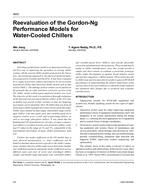Description
Selecting a performance model is an important and essential first step in improving the operation of existing chiller systems. Of the several chiller models proposed in the literature, one promising approach is the physical model formulation proposed by Gordon and Ng (GN). It has been evaluated by a couple of previous studies and found to be less accurate in predictive ability than black-box chiller models such as that used by DOE-2. The findings of these studies can be faulted on the grounds that an older and more restrictive version of the GN chiller model (called quasi-empirical model) was used. The objective of this study is to perform a thorough evaluation of the internal and external predictive ability of the GN class of models and several of their variants so that any lingering uncertainty can be dispelled. Over 50 chiller data sets from all of the major chiller manufacturers have been used in this study. Chiller types studied include single- and double-stage centrifugal chillers with inlet guide vane and variable-speed drive capacity control, screw, scroll, and reciprocating chillers, as well as two-stage absorption chillers. It was found that the fundamental GN formulation for all types of vapor compression chillers is excellent in terms of its predictive ability, yielding CV values in the range of 2% and 5%, comparable to the experimental uncertainty of many chiller performance data sets. Further, the model coefficients in the GN models have a clear physical interpretation, i.e, these coefficients can be linked to thermal characteristics specific to the chiller components. Another objective of this study was to determine whether one could detect patterns among the model coefficients across different types and sizes of screw and centrifugal chillers (single- and double-stage inlet guide vane controlled chillers and variable-speed drive chillers) and provide physically consistent explanations for these patterns. These trends may be useful to chiller manufacturers since this would provide a simple and direct means to evaluate a particular prototype chiller under development as against broad industry trends and specific competitor’s chiller models. These trends specific to chiller type and size may also be useful to general HVAC&R practitioners in understanding the relative importance of the various sources of irreversibilities to which the chiller industry has optimized their designs due to technical and economic considerations.
Units: Dual
Citation: ASHRAE Transactions, vol. 109, pt. 1
Product Details
- Published:
- 2003
- Number of Pages:
- 16
- File Size:
- 1 file , 630 KB
- Product Code(s):
- D-20935




